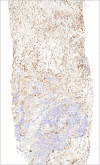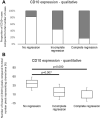Predictive role of neostromal CD10 expression in breast cancer patients treated with neoadjuvant chemotherapy
- PMID: 36685105
- PMCID: PMC9849231
- DOI: 10.3389/pore.2022.1610598
Predictive role of neostromal CD10 expression in breast cancer patients treated with neoadjuvant chemotherapy
Abstract
Background: The therapeutic strategy of invasive breast cancer is based on routine histopathological markers (estrogen-, progesterone receptor, HER2, Ki67) routinely evaluated in tumor cells. However, the assessment of cancer stroma could influence therapeutic strategies. Studies have shown that stromal expression of CD10, a zinc-dependent metalloproteinase, is associated with biological aggressiveness of the tumor. In the present retrospective study, we aimed to evaluate stromal CD10 expression and association between CD10 expression and response to neoadjuvant chemotherapy in invasive breast cancer. Methods: CD10 immunohistochemistry was performed on core biopsies taken before the neoadjuvant therapy. Stromal CD10 expression was determined and compared with well-known predictive and prognostic tissue markers as well as with the following groups defined according to the degree of tumor response: no regression, partial regression, and complete regression. Results: A total of 60 locally advanced invasive breast carcinomas of "no special type" were included. The proportion of CD10 positive tumors was significantly higher in the "no regression" group compared to "complete regression" group (p = 0.000). Stromal CD10 expression was found to be significantly associated with decrease in response to neoadjuvant chemotherapy. According to CD10 expression we did not find any difference in hormone receptor status, Ki67, tumor grade or neostromal area. Conclusion: Our data suggest that CD10 expression can serve as a predictive marker of the effect of neoadjuvant chemotherapy in breast cancer patients. Therefore, its inclusion into the routine assessment of biopsies to tailor tumor-specific therapeutic strategies merits consideration.
Keywords: CD10; advanced breast cancer; neoadjuvant therapy; neostroma; predictive factors.
Copyright © 2023 Olah, Majlat, Koszo, Vereb and Voros.
Conflict of interest statement
The authors declare that the research was conducted in the absence of any commercial or financial relationships that could be construed as a potential conflict of interest.
Figures




Similar articles
-
CD10-a new prognostic stromal marker in breast carcinoma, its utility, limitations and role in breast cancer pathogenesis.Indian J Pathol Microbiol. 2014 Oct-Dec;57(4):530-6. doi: 10.4103/0377-4929.142639. Indian J Pathol Microbiol. 2014. PMID: 25308002
-
Expression of ER, PgR, HER-2, and Ki-67 in core biopsies and in definitive histological specimens in patients with locally advanced breast cancer treated with neoadjuvant chemotherapy.Cancer Chemother Pharmacol. 2020 Jan;85(1):105-111. doi: 10.1007/s00280-019-03981-5. Epub 2019 Nov 21. Cancer Chemother Pharmacol. 2020. PMID: 31754747
-
Effect of neoadjuvant chemotherapy on stromal CD10 antigens in breast cancer - a preliminary study.Indian J Cancer. 2013 Jan-Mar;50(1):46-51. doi: 10.4103/0019-509X.112299. Indian J Cancer. 2013. PMID: 23713046
-
The role of immunohistochemistry in breast cancer patients treated with neoadjuvant chemotherapy: an old tool with an enduring prognostic value.Clin Breast Cancer. 2013 Apr;13(2):146-52. doi: 10.1016/j.clbc.2012.11.006. Epub 2013 Jan 11. Clin Breast Cancer. 2013. PMID: 23318089 Clinical Trial.
-
A comprehensive review of the literature on CD10: its function, clinical application, and prospects.Front Pharmacol. 2024 Feb 8;15:1336310. doi: 10.3389/fphar.2024.1336310. eCollection 2024. Front Pharmacol. 2024. PMID: 38389922 Free PMC article. Review.
References
MeSH terms
Substances
LinkOut - more resources
Full Text Sources
Medical
Research Materials
Miscellaneous

